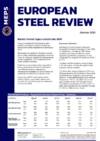Year-end uncertainties curb European buying activity
At the start of December, steel service centres and distributors were struggling to establish the market direction. Mills’ official prices remained elevated, but stock levels rose as steel consumption reduced.
2021 has been a successful year for steel producers. They have enjoyed excellent margins and are keen to maintain these into 2022. Healthy profits are essential to support decarbonisation in the industry. Across all steel-consuming sectors, from carmakers to racking producers, demand for “green” steel is increasing. This adds to the pressure for large-scale investment in fossil fuel-free steelmaking technologies.
European coil mills, which are still in protracted negotiations with automotive manufacturers, are attempting to hold their official prices. Carmakers, however, are slow to conclude deals, while the semiconductor shortage persists. Steel inventories are growing across the supply chain, as call-offs diminish.
Steelmakers are trying to offload surplus stock and fill gaps in rolling programmes by proposing short-term individual discounts to customers – while maintaining their headline prices. Such practice is common, in December, but usually on a small scale. This month, these deals are widespread and this pricing information has leaked into the market. This heightens uncertainty amongst buyers.
Distributors, meanwhile, which hold adequate inventory, are now uncertain whether actual prices will recover in January. Some even anticipate further reductions and are reluctant to book new business. The opening of the next quota period, on January 1, will lead to increased downward price pressure from imports. However, this will be restricted by a lack of unloading capacity at European ports and continuing problems with transport across the region.
Maintenance programmes were brought forward by steelmakers, to reduce output in December. A shortage of workers, caused by enhanced Covid-19 measures in several territories, also hampers production. A number of market participants forecast that this will bring price stability.
The prospective boost offered by the recent US-EU trade deal is limited in scope. The detailed breakdown of quotas for tariff-free imports into the United States provides little opportunity for a significant increase in trade. North American commodity grade steel prices are also declining, lessening the attraction for EU suppliers.

Source:
European Steel Review
The MEPS European Steel Review is an informative, concise and easy-to-use monthly publication, offering unique professional insight into European carbon steel prices.
Go to productRequest a free publication





